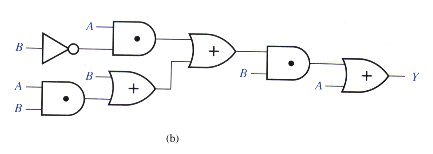
Decimal Conversion:
Binary to Decimal:
Hexadecimal to Decimal:
Decimal to Binary:
Quotient: 0 1 3 7 14 28 56 112 225 Remaindr: 1 1 1 0 0 0 0 1(Fraction: .75) Method: Repeated "multiplication" by 2
Fraction: .75 .5 0
Integral: 1 1
Therefore: 225.7510 = 11100001.112 Decimal to Hexadecimal:
Quotient: 0 14 225 Remaindr: 14 1(Fraction: .75) Method: Repeated "multiplication" by 16
Fraction: .75 0 Integral: 12Therefore: 225.7510 = E1.C16
Dec 8421 6311 2421 Excess-3 Gray 2-out-of-5 ----------------------------------------------------------------- 0 0000 0000 0000 0011 0000 00011 1 0001 0001 0001 0100 0001 00101 2 0010 0011 0010 0101 0011 00110 3 0011 0100 0011 0110 0010 01001 4 0100 0101 0100 0111 0110 01010 5 0101 0111 1011 1000 1110 01100 6 0110 1000 1100 1001 1010 10001 7 0111 1001 1101 1010 1011 10010 8 1000 1011 1110 1011 1001 10100 9 1001 1100 1111 1100 1000 11000 ------------------------------------------------------------------
ASCII Code
char Binary Hex
---------------------------
space 010 0000 20
! 010 0001 21
" 010 0010 22
# 010 0011 23
...
0 011 0000 30
1 011 0001 31
2 011 0010 32
...
9 011 1001 39
...
A 100 0000 40
B 100 0001 41
C 100 0010 42
...
a 110 0000 60
b 110 0001 61
c 110 0010 62
...
| Operations with 0 and 1: (1) A + 0 = A (2) A + 1 = 1 |
. (1d) A1 = A (2d) A0 = 0 |
| Idempotent Laws: (3) A + A = A |
. (3d) AA = A |
| Involution Law: (4) (A')' = A |
. . |
| Laws of Complementarity: (5) A + A' = 1 |
. (5d) AA' = 0 |
| Commutative Laws: (6) A + B = B + A |
. (6d) AB = BA |
| Associative Laws: (7) (A + B) + C = A + (B + C) = A + B + C |
. (7d) (AB)C = A(BC) = ABC |
| Distributive Laws: (8) A(B + C) = AB + AC |
. (8d) A + BC = (A + B)(A + C) |
| Simplification Theorems: (9) AB + AB' = A (10) A + AB = A (11) (A + B')B = AB |
. (9d) (A + B)(A + B')= A (10d) A(A + B) = A (11d) AB' + B = A + B |
| DeMorgan's Laws:. (12) (A + B + C + *)' = A'B'C'... (13) [ f(A1,A2,...,AN, 0, 1, +, *) ]' =f(A1',A2',...,AN',1, 0, *, +) |
. (12d) (ABC...)'= A = A' + B' + C' + ... . . |
| Duality:. (14) (A + B + C + ...)^D = ABC... (15) [ f(A1,A2,..,AN,0,1,+,*) ]^D = f(A1,A2,...,AN,1,0,*,+) |
. 14d) (ABC...)^D = A + B + C + ... . . |
| Theorem for Multiplying Out and Factoring:. (16) (A + B)(A' + C) =AC + A'B (15) [ f(A1,A2,..,AN,0,1,+,*) ]^D |
. (16d) AB + A'C = (A + C)(A' + B) |
| Consensus Theorem:. (17) AB + BC + A'C = AB + A'C |
. (17d) (A + B)(B + C)(A' + C) = (A + B)(A' + C) |

ANSWER:
Clearly, circuit output is
Y = A + B [ A B' + (A B + B ) ]
Therefore, Y = A + 0 + B = A + B
Simplify: (A' + C' + D)(A + B' + C')(B + C')
ANSWER:
(A' + C' + D)(A + B' + C')(B + C') = (A' + C' + D)(AB + AC' + B'C' + BC' +
C')
= (A' + C' +D)(AB + C') = A' + C' + BD
Refer to Chapter 2. AB + A'C + BC = AB + A'C
Simplify F = ABC' + ABC'D' + ABD'E + A'EFG + CD'EG + CD'EG' (reduce to three terms)
ANSWER:
F = ABC' + ABD'E + A'EFG + CD'E = ABC' + CD'E + A'EFG